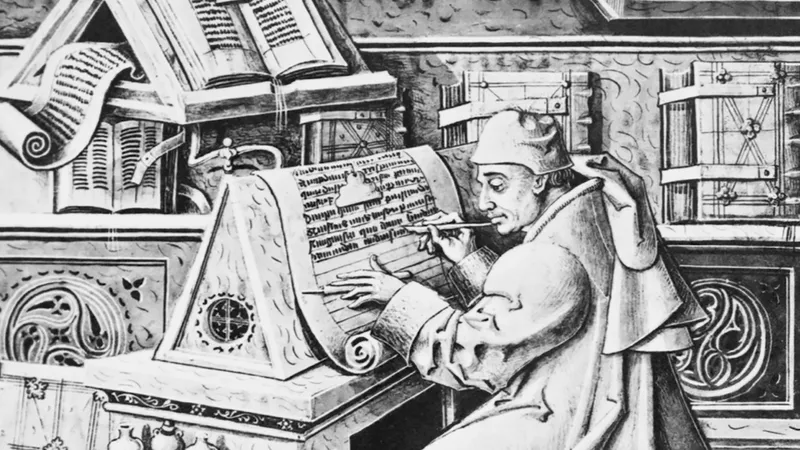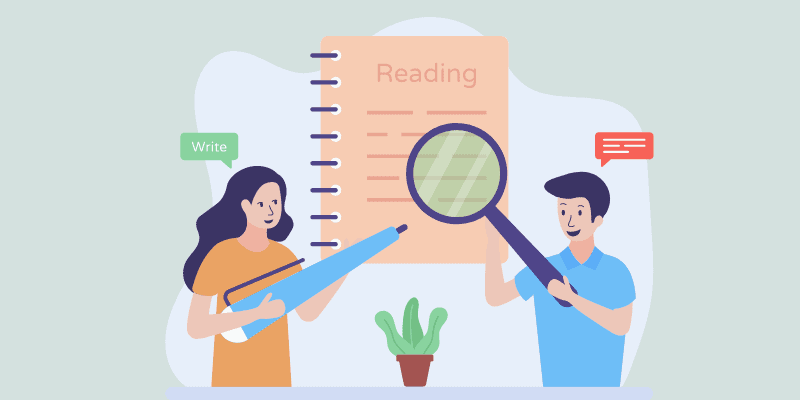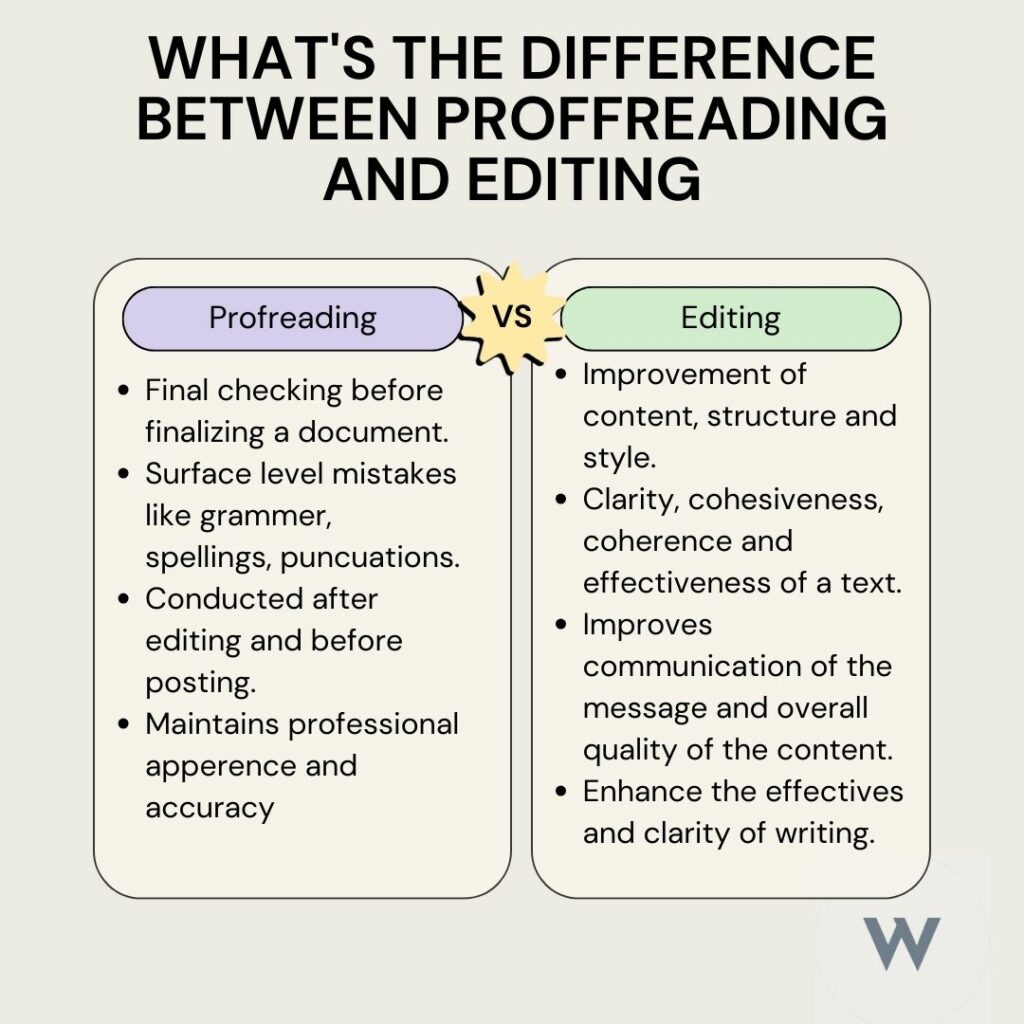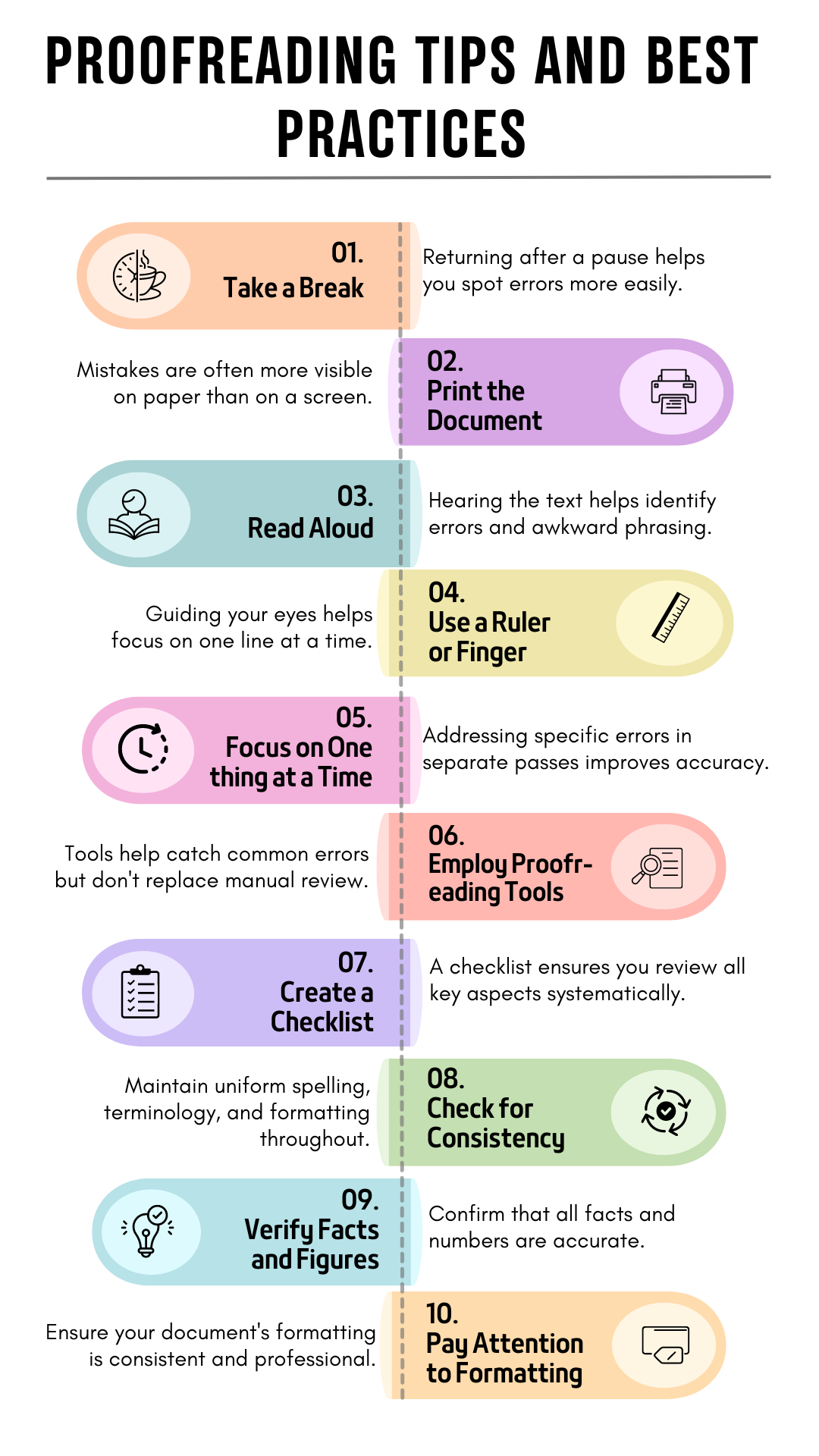Have you ever noticed how a small punctuation mark can change everything? Or how can one wrong word mess up a whole sentence? Welcome to the world of proofreading, where every detail matters and each comma counts.
According to the Cambridge Dictionary, the act of finding and correcting mistakes in copies of printed text before the final copies are printed.
Proofreading is the last step in the writing process. It involves carefully checking text to find and fix mistakes.
This important task makes sure that documents are free from grammar errors, spelling mistakes, and issues with punctuation and formatting. Good proofreading is important in many areas, like academic writing, business communication, and publishing.
The importance of proofreading cannot be overstated in various fields, including academia, business, and publishing.
In academic settings, proofreading is essential for students, researchers, and educators who need to ensure that their work is communicated and free from mistakes that could undermine their credibility or affect their grades. A well-proofread academic paper not only demonstrates the author’s attention to detail but also enhances the overall readability and impact of the research.
Professional documents such as reports, emails, proposals, and marketing materials reflect the company’s image and professionalism. Errors in these documents can lead to misunderstandings, damage a company’s reputation, and result in lost opportunities or financial losses.
In the publishing industry, proofreading is the final step before a book, magazine, or any other form of written content goes to print. Given the public nature of these materials, even minor errors can have significant consequences, including negative reviews and diminished reader trust.
The proofreading process itself is systematic and methodical, typically involving several steps to ensure thoroughness and accuracy. Proofreaders often use style guides specific to their industry or publication to maintain consistency and adherence to established standards.
The process involves multiple rounds of review, especially for lengthy or complex documents. After each round, corrections are made, and the text is re-evaluated to ensure that no new errors have been introduced and that all previous mistakes have been corrected. This iterative approach helps to refine the document further, making it as error-free as possible.
What is Proofreading?
Proofreading is a detailed process designed to catch and correct errors in written texts. It typically involves several steps to ensure thoroughness and accuracy and often uses style guides specific to the industry or publication to maintain consistency and adherence to established standards.
The process involves multiple rounds of review, especially for lengthy or complex documents. After each round, corrections are made, and the text is re-evaluated to ensure that no new errors have been introduced and that all previous mistakes have been corrected. This iterative approach helps to refine the document further, making it as error-free as possible.
In the initial stages of proofreading, the focus is often on surface errors such as spelling, grammar, and punctuation. These elements are crucial for maintaining the credibility of the document. Small mistakes can distract readers and undermine the author’s authority, so catching these errors early is essential.
Subsequent rounds of proofreading delve deeper into the content, ensuring that the document’s structure and flow are logical and coherent. Proofreaders look at sentence construction, word choice, and overall readability. They also ensure that the document adheres to the required formatting and style guidelines, which is particularly important in academic and professional writing.
Finally, proofreaders check for consistency in terminology and formatting. This includes verifying that all headings, subheadings, and references are consistent throughout the document. Consistency helps to enhance the document’s professionalism and makes it easier for readers to follow and understand the content. Through this meticulous process, proofreaders play a vital role in preparing a polished and effective final document.
History of Proofreading
Proofreading has been around for a long time, starting with the invention of the printing press in the 15th century. Early printers needed to make sure their texts were error-free before printing because fixing mistakes afterward was hard and expensive.

As printing technology got better, so did proofreading methods. By the 19th century, proofreading became a specialized job, with professional proofreaders working for publishing companies. They used special marks and symbols to show corrections on manuscripts.
Today, in the digital age, proofreading has become easier with software tools. These tools help spot and fix errors quickly, but human proofreaders are still needed to ensure the text is perfect. Despite new technology, careful human review remains a crucial part of proofreading.
Why Proofreading is important?
Here is why proofreading is vital in the writing process: it ensures documents are error-free, clear, and professional. It enhances the credibility and readability of the text, maintains consistency, and prevents costly mistakes.
Errors in a document can undermine the writer’s authority and distract readers from the content.
By eliminating these errors, proofreading helps ensure that the document is taken seriously and the message is conveyed accurately.
Proofreading enhances document readability and clarity. Errors can confuse readers and obscure intended meanings, especially in professional and academic writing. Proofreaders correct grammatical mistakes, refine sentence structures, and improve word choices.
Consistency is crucial in effective writing. Documents often follow specific style guides (such as APA, MLA, or Chicago), and proofreading ensures adherence to these guidelines throughout the text. This includes maintaining uniformity in headings, subheadings, citations, and terminology.
Thorough proofreading also prevents costly errors. Mistakes in business reports or marketing materials can harm a company’s reputation or lead to financial losses. By investing in proofreading, businesses and individuals avoid such pitfalls.
Moreover, proofreading develops valuable skills like attention to detail and critical thinking. Regular practice improves overall communication abilities. Proficient writers identify and correct errors efficiently, producing high-quality work.
Whether done in-house or outsourced, thorough proofreading is essential for polished and effective written communication.
Different Types of Proofreading
Proofreading is a diverse field tailored to different types of content, each needing specific skills and attention to detail. Here are the main types of proofreading:

Academic Proofreading
Academic Proofreading focuses on ensuring scholarly papers are clear and error-free. This includes checking grammar, punctuation, and spelling.
Academic proofreaders also ensure citations and references are correct, which is crucial for maintaining academic integrity. By polishing the text, they help students, researchers, and professors present their work professionally and clearly.
Business Proofreading
Business Proofreading involves reviewing documents such as reports, emails, presentations, and proposals. Accuracy in business communication is vital, as errors can damage a company’s reputation.
Proofreaders in this field look for clarity, professionalism, and consistency in tone. They ensure the message is precise and compelling, which is crucial for internal communication and client relations.
Technical Proofreading
Technical Proofreading deals with documents related to specialized fields like engineering, IT, and science. This type requires proofreaders to have a strong understanding of the subject matter to accurately check terminology and jargon.
They ensure that manuals, guides, and technical papers are not only free from errors but also easy to understand for the target audience. This precision helps in preventing costly mistakes and ensuring user safety.
Creative Writing Proofreading
Creative Writing Proofreading focuses on works like novels, short stories, and poems. Here, the emphasis is on maintaining the author’s voice and style while correcting errors. Proofreaders check for consistency in plot, character names, and timelines.
They also look for repetitive words and awkward phrases. By doing so, they help authors present their stories in the best possible light, making them more engaging and enjoyable for readers.
Legal Proofreading
Legal Proofreading involves reviewing legal documents such as contracts, agreements, and court documents. Precision is crucial in this field because even a minor error can have significant legal implications.
Proofreaders ensure that all legal terms are used correctly and consistently. They also check that citations and references are accurate. This meticulous attention to detail helps lawyers and legal professionals avoid misunderstandings and legal disputes.
Scientific Proofreading
Scientific Proofreading focuses on research papers, journal articles, and scientific reports. Proofreaders in this field ensure that the language is clear and concise and that the terminology is used correctly.
They also check that data and figures are presented accurately and that references are correctly formatted. This ensures that scientific findings are communicated effectively and can be trusted by the scientific community.
Marketing Proofreading
Marketing Proofreading involves reviewing content such as advertisements, brochures, and social media posts.
The goal is to ensure that the message is clear, persuasive, and error-free. Proofreaders check for consistency in brand voice and tone, as well as for correct spelling, grammar, and punctuation. This helps businesses effectively communicate with their audience and build a strong brand image.
Medical Proofreading
Medical Proofreading deals with documents like medical reports, patient information leaflets, and research papers.
Proofreaders need to have a good understanding of medical terminology and ensure that all information is accurate and presented. This type of proofreading is essential for maintaining patient safety and ensuring that medical professionals have reliable information.
Copyediting
Copyediting involves proofreading for errors and correcting sentence structure, word choice, and overall flow.
This type of proofreading is more in-depth and is often used for manuscripts, articles, and other content requiring substantial readability and style improvement.
ESL Proofreading
ESL (English as a Second Language) Proofreading is focused on helping non-native English speakers.
Proofreaders ensure that the content is grammatically correct, clear, and idiomatic. This type is beneficial for academic papers, business documents, and other formal writings where clear communication is essential.
Resume and CV Proofreading
Proofreading resumes and CVs is crucial as these documents are vital for job applications. Proofreaders ensure that all details are accurate, grammar and spelling are flawless, and the formatting is professional.
This type of proofreading helps job seekers present themselves in the best possible light to potential employers.
Website Proofreading
Website Proofreading focuses on content published online. Proofreaders check for errors in text, links, and multimedia elements.
They ensure that web content is accessible, error-free, and user-friendly. This is important for maintaining a website’s credibility and enhancing the user experience.
Script Proofreading
Script Proofreading is used for screenplays, stage plays, and other scripts. The proofreader checks for errors in dialogue, character names, and stage directions. They also ensure that the script follows the correct formatting guidelines.
This is essential for the smooth production of the script in a performance setting.
Financial Proofreading
Financial Proofreading is focused on documents such as financial reports, audits, and statements.
Proofreaders ensure that numbers are accurate, terms are used correctly, and the information is presented clearly. This type of proofreading helps prevent costly mistakes and ensures that financial documents are reliable.
Advertising Proofreading
Advertising Proofreading is crucial for marketing materials such as print ads, billboards, and online ads. The proofreader ensures that the message is clear, persuasive, and error-free.
They also check for consistency in branding and tone. This type of proofreading helps businesses effectively reach and influence their target audience.
Publishing Proofreading
Publishing Proofreading is the final check before a book, magazine, or journal is published. Proofreaders check for any remaining errors in the text, formatting, and layout.
They also ensure that all elements of the publication are aligned correctly. This type of proofreading is crucial for maintaining the quality and professionalism of the publication.
Bilingual Proofreading
Bilingual Proofreading involves checking content that has been translated from one language to another. The proofreader ensures that the translation is accurate and that the content reads naturally in the target language.
This type of proofreading is important for businesses and individuals who need to communicate effectively in multiple languages.
Digital Content Proofreading
Digital Content Proofreading is specialized for content that will be published online, including blogs, social media posts, and emails.
Proofreaders ensure that the content is concise, error-free, and optimized for online reading. They also check for issues like broken links or incorrect formatting. This type of proofreading is vital for maintaining a professional online presence.
Proofreading ensures that all types of content are clear, accurate, and professional, helping maintain credibility and effectiveness in communication.
Step by Step process of proofreading
Here’s a simple guide to help you understand each step, along with some useful tools and techniques.
Step 1: Initial Reading
First Impressions Start by reading your document from start to finish without making any changes. This helps you get an overall sense of the content and structure. Look for any glaring errors or areas that might need major revisions.
Focus on Content During this first read, focus on the main ideas and their logical flow. Make sure all points are clear, and the document has a coherent structure. This initial reading helps you see the big picture before diving into the details.
Step 2: Detailed Review
Grammar and Punctuation After the initial read, go back and review for grammar, punctuation, and spelling errors. Common issues to look out for include subject-verb agreement, correct use of commas and periods, and proper spelling.
- Grammar Checks: Ensure sentences are grammatically correct and make sense.
- Punctuation: Check that punctuation marks are used correctly and appropriately.
- Spelling: Look for any misspelled words or typographical errors.
Sentence Structure Examine each sentence for clarity and simplicity. Break down long, complex sentences into shorter ones to improve readability. Ensure each sentence conveys its intended meaning.
Consistency Checks Consistency is key to a professional document. Check for consistent use of terms, names, dates, and style elements like capitalization and hyphenation. Ensure that all headings and subheadings follow a consistent format.
Step 3: Review Formatting and Style
Formatting Proper formatting is crucial for a professional-looking document. Check margins, font size and style, line spacing, and paragraph alignment. Ensure that headings and subheadings are consistent and that the overall layout is clean and organized.
Style Guide Adherence If your document needs to follow a specific style guide (like APA, MLA, or Chicago), ensure it adheres to all the required guidelines. This includes correct citation formatting, appropriate use of headings, and overall presentation style.
Step 4: Final Read-Through
Polishing the Text After making all necessary corrections, read through the document one last time. This final read-through ensures that all errors have been fixed and that no new ones were introduced during the editing process.
Fresh Perspective Taking a break before the final read-through or having someone else review the document can provide a fresh perspective. A new pair of eyes is more likely to spot errors you might have missed.
Difference Between Proofreading and Editing
The term “proofreading” is sometimes incorrectly used to refer to copy editing, and vice versa. Although there is necessarily some overlap, proofreaders typically need more real editorial or managerial authority. They can mark queries for typesetters, editors, or authors.

Proofreading and editing are two distinct yet complementary stages in the writing process. Each serves a specific role in refining and polishing a document to ensure it meets high standards of quality.
Proofreading
Proofreading is the final check before a document is finalized. Its main job is to spot and correct surface-level mistakes like spelling errors, grammatical issues, and punctuation problems. Proofreaders ensure that the text is consistent and polished. They focus on minor errors without altering the content or overall structure of the document.
It typically involves reading through the text carefully to catch any overlooked errors. This stage is crucial for eliminating mistakes that could detract from the document’s professionalism. Proofreaders use tools and techniques to spot typographical errors and inconsistencies. Their goal is to ensure that the final version of the document is clean and error-free.
It is often performed after editing, as it focuses on catching any final errors that may have slipped through during the editing process. It’s a crucial step in ensuring that the document is polished and ready for its intended audience. Proofreaders also check for formatting issues and ensure consistency in the use of fonts, headings, and other stylistic elements.
Proofreading is generally the last step before a document is published or submitted. It ensures that the final version is free from typographical and minor grammatical errors. Proofreading helps in maintaining a professional appearance and ensures that the document meets high standards of accuracy.
Editing
Editing, on the other hand, is a more comprehensive process. It involves reviewing and improving the overall content, structure, and style of the writing. Editors work to enhance the document’s clarity, coherence, and effectiveness. They might reorganize sections, rewrite sentences, and suggest improvements to make the text more engaging.
Editing can be divided into several stages. Developmental editing focuses on the big picture, such as the overall structure and flow of the document. Substantive editing deals with content accuracy and logical consistency. Line editing hones the language and style, ensuring that sentences are clear and impactful.
Editors aim to improve how the document communicates its message. They address issues related to organization, argumentation, and narrative flow. This can involve reworking paragraphs, refining arguments, and enhancing readability. Effective editing ensures that the text is not only correct but also compelling and well-structured.
In contrast, editing is a more dynamic and iterative process. It involves a deeper examination of the content and often requires multiple rounds of revisions. Editors might work closely with the author to refine ideas and improve the overall quality of the document. This process can significantly impact the effectiveness and clarity of the writing.
Editing is an ongoing process that can happen at various stages of writing. It involves making significant changes to enhance the document’s overall quality. Editors provide valuable feedback and suggestions that help in shaping the final product. Both proofreading and editing are essential for producing high-quality writing, but they focus on different aspects of the text.
Skills Required for Proofreading
Here is a list of skills that are required to be a good proofreader..
Attention to Detail
It is the most crucial skill for a proofreader. This involves carefully examining every word, punctuation mark, and formatting element to spot mistakes that others might overlook. Proofreaders need to be meticulous in their approach, as even small errors can impact the document’s professionalism and clarity.
Strong Grammar Knowledge
Strong knowledge of grammar is essential for identifying and correcting grammatical errors. Proofreaders should have a solid understanding of grammar rules, including sentence structure, verb tenses, and subject-verb agreement. This knowledge helps them spot mistakes and ensure that the text adheres to proper grammatical standards.
Excellent Spelling Skills
This is also vital. Proofreaders must be proficient in recognizing correct spelling and be aware of common spelling mistakes and homophones. They should be familiar with the correct spelling of frequently used words and names, as well as variations between different English standards (e.g., American vs. British spelling).
Understanding of Punctuation Rules
Proofreaders need to know how to use punctuation marks correctly, including commas, periods, semicolons, and quotation marks. Proper punctuation is essential for clarity and readability, so proofreaders must ensure that punctuation is used accurately throughout the document.
Consistency Checking
This involves ensuring that the document follows a consistent style and format. Proofreaders need to verify that elements such as headings, font styles, and formatting are uniform throughout the text. Consistency contributes to a professional appearance and helps in maintaining a cohesive document.
Familiarity with Style Guides
Many documents follow specific style guides, such as APA, MLA, or Chicago. Proofreaders should be familiar with these guides to ensure that the document adheres to the required style and formatting rules.
Patience and Focus
Proofreading can be time-consuming and requires sustained concentration to catch errors. Proofreaders must remain patient and focused throughout the process to ensure that every aspect of the text is thoroughly reviewed.
The ability to Work Independently
Proofreaders often need to review documents on their own. They must be able to make decisions about corrections and improvements without relying on others for guidance.
Critical Thinking
Proofreaders need to analyze the content critically to identify obvious errors and subtle issues that might affect the meaning or tone. This involves questioning the text’s clarity, logic, and flow to ensure it conveys the intended message effectively.
Time Management
Proofreading often comes with tight deadlines, so managing time efficiently is crucial. Proofreaders must be able to prioritize tasks and work within the given time frame without compromising the quality of their work.
Adaptability
Proofreaders need to be adaptable to work with different types of content, from technical documents to creative writing. This skill allows them to adjust their approach depending on the document’s purpose, audience, and style.
Communication Skills
While proofreading is often a solitary task, proofreaders must communicate effectively with authors or editors about suggested changes. Clear communication ensures that the reasoning behind corrections is understood and accepted.
Attention to Context
Understanding the context in which a document is written is important for effective proofreading. This involves recognizing the tone, audience, and purpose of the text to ensure that corrections align with the overall message and goals of the document.
Proofreading for Different Formats and their nuances
Different formats—print, digital, and others—each come with their own set of nuances and considerations. Understanding these differences is crucial for effective proofreading across various media.
Print Formats
Proofreading print materials involves focusing on how text appears on physical pages. This includes reviewing documents such as books, brochures, flyers, and reports. Key considerations for proofreading print formats include:
- Layout and Formatting: Print documents require attention to visual layout, including margins, spacing, and alignment. Proofreaders need to ensure that text is properly aligned with images, headings, and other elements. Consistency in font size and style is critical for maintaining a professional appearance.
- Typography: Print proofreading involves checking the use of fonts and typefaces. This includes ensuring that text is readable and that font choices are appropriate for the document’s purpose. Proofreaders must verify that headings, subheadings, and body text are formatted consistently.
- Proof Copies: Reviewing physical proof copies can help identify errors that may not be apparent on a screen. Proofreaders should examine the printed pages closely to catch issues with text placement, color contrasts, and overall visual coherence.
- Visual Elements: Print materials often include images, charts, and graphs. Proofreaders need to check that these visual elements are correctly labeled and referenced in the text. Ensuring that captions and descriptions are accurate and align with the visual content is essential.
Digital Formats
Digital documents, including web content, e-books, and online articles, present different proofreading challenges. Key aspects to consider when proofreading digital formats include:
- Hyperlinks and Interactive Elements: Digital documents often include hyperlinks, buttons, and interactive features. Proofreaders must verify that all links are functional and direct users to the correct pages. They should also check that interactive elements, such as forms or buttons, work as intended.
- Responsive Design: For web content, proofreading involves checking how the text displays across different devices and screen sizes. Proofreaders should ensure that the content is legible and visually appealing on smartphones, tablets, and desktop computers.
- SEO Considerations: Digital content often needs to be optimized for search engines. Proofreaders should be aware of SEO best practices, such as keyword usage, meta descriptions, and alt text for images. Ensuring that these elements are correctly implemented can enhance the document’s visibility online.
- Accessibility: Proofreading digital content also involves checking for accessibility. This includes verifying that the text is readable by screen readers and that there are sufficient contrast levels between text and background. Ensuring that alt text is provided for images and that documents comply with accessibility standards is important for inclusivity.
Other Formats
Proofreading for formats like audio scripts, video subtitles, and presentations involves unique considerations:
- Audio Scripts: For audio scripts, proofreading focuses on ensuring that the text is clear and suitable for spoken delivery. Proofreaders need to consider how the script will sound when read aloud, checking for natural flow and timing. They should also verify that the script matches the intended tone and pacing.
- Video Subtitles: Subtitles need to be accurate and synchronized with the video content. Proofreaders must ensure that subtitles are free of errors and match the spoken dialogue in terms of timing and content. It’s important to check that subtitles are concise and easy to read within the limited display time.
- Presentations: Proofreading presentations involves checking the content of slides for clarity and coherence. This includes reviewing text, images, and graphs to ensure that they support the presentation’s message effectively. Proofreaders should also check for consistency in slide design and formatting.
General Considerations
Regardless of the format, some general proofreading practices apply:
- Consistency: Consistency in style, tone, and formatting is crucial across all formats. Proofreaders should ensure that the document adheres to any established guidelines or style guides, whether for print, digital, or other media.
- Accuracy: Ensuring that all factual information is correct is essential in all formats. Proofreaders should verify names, dates, statistics, and other data to prevent misinformation.
- Readability: The document should be clear and easy to understand. Proofreaders need to check for readability issues, such as overly complex sentences or jargon that might confuse readers.
- Final Review: Each format may require a final review phase. For print, this might be a review of the physical proof; for digital formats, it might involve checking how the content looks live on the web.
Proofreading Tips and Best Practices

Take a Break
- Allow your brain to reset: Stepping away from your document gives your brain a chance to reset, which can make it easier to spot mistakes. According to cognitive psychology, a break allows the brain to reduce cognitive load and regain focus, making it more likely that errors will be noticed when you return.
- Shift your perspective: This break also helps you switch from the role of the writer to that of the reader, which is essential for effective proofreading.
Print the Document
- Engage different senses: Reading on paper engages different cognitive processes than reading on a screen. Research shows that reading printed text can improve comprehension and error detection because it slows down the reading process, allowing for more detailed focus.
- Marking by hand: Physically marking errors with a pen can also reinforce memory, making it easier to recall and correct mistakes later.
Read Aloud
- Auditory processing: When you read aloud, you engage the auditory parts of your brain, which can help in catching awkward phrasing and missing words. Scientific studies suggest that reading aloud forces a deeper level of cognitive engagement, which aids in detecting errors that silent reading might miss.
- Pacing your reading: This method also naturally slows down your reading pace, which improves your ability to spot errors.
Use a Ruler or Finger
- Preventing skipped lines: Using a ruler or finger helps you track each line of text, reducing the likelihood of skipping lines, which is common when reading long documents.
- Enhanced focus: This method narrows your focus to one line at a time, which minimizes distractions and enhances your ability to detect errors.
Focus on One Type of Error at a Time
- Reduce cognitive overload: By focusing on one type of error (e.g., spelling, punctuation), you reduce cognitive overload, making it easier to catch mistakes. This systematic approach aligns with how the brain processes information, allowing for more thorough proofreading.
- Targeted correction: This technique ensures that specific types of errors are corrected thoroughly before moving on to the next type.
Employ Proofreading Tools
- Supplement manual proofreading: Tools like Grammarly and Hemingway help identify errors that might be missed manually. While these tools are not foolproof, they are based on advanced algorithms that analyze grammar, syntax, and style, making them valuable as a secondary check.
- Improving consistency: Automated tools are particularly useful for maintaining consistency in style and tone, as they can apply rules uniformly across the document.
Create a Checklist
- Ensure comprehensive review: A checklist helps ensure that no aspect of proofreading is overlooked. By systematically working through a list of potential issues (e.g., homophones, formatting), you can cover all bases.
- Consistency and thoroughness: Checklists are effective because they break down the task into manageable parts, which aligns with how the brain processes and retains information.
Check for Consistency
- Maintain professional appearance: Consistent use of fonts, headings, and styles creates a cohesive document, which is easier for readers to navigate. Inconsistencies can distract readers and undermine the document’s professionalism.
- Improve reader comprehension: Consistency also aids in readability and comprehension, as readers can predict the structure and format of the document.
Verify Facts and Figures
- Maintain credibility: Double-checking factual information is crucial for maintaining the document’s credibility. Errors in data or citations can lead to misinformation, which can damage the writer’s reputation.
- Prevent miscommunication: Accurate facts and figures ensure that the document communicates the intended message effectively, which is particularly important in academic and professional writing.
Pay Attention to Formatting
- Enhance readability: Proper formatting (e.g., margins, and line spacing) enhances the document’s readability, making it easier for readers to follow the content. Formatting errors can disrupt the reading flow and make the document appear unprofessional.
- Adhere to standards: In professional and academic settings, adhering to formatting standards is essential for compliance and credibility.
Break It Down
- Prevent fatigue: Dividing the task into smaller sections helps prevent cognitive fatigue, which can lead to missed errors. Research shows that shorter, focused sessions are more effective for detail-oriented tasks like proofreading.
- Maintain concentration: This method ensures that your attention remains sharp, allowing for more accurate error detection.
Review in Stages
- Layered error detection: Reviewing the document in multiple stages allows you to focus on different aspects of proofreading, such as grammar in one round and formatting in another. This staged approach aligns with cognitive load theory, which suggests that breaking tasks into smaller components enhances accuracy and retention.
- Thorough coverage: Multiple rounds ensure a more thorough review, catching errors that may be missed in a single pass.
Seek a Second Opinion
- Gain fresh perspective: A second pair of eyes can spot errors you’ve missed due to familiarity with the text. Research in cognitive psychology shows that unfamiliarity with the content can make someone more likely to make mistakes.
- Validate clarity: A second reader can also provide feedback on the clarity and coherence of the document, ensuring that the intended message is effectively communicated.
Look for Common Errors
- Personal error patterns: Being aware of your common mistakes allows you to focus on those areas during proofreading. This self-awareness is supported by cognitive behavioral strategies, which emphasize the identification and correction of recurring patterns.
- Improve efficiency: Targeting common errors improves proofreading efficiency and reduces the likelihood of repeated mistakes.
Stay Consistent with Style Guides
- Adhere to standards: Consistency with style guides (APA, MLA) is crucial for professional and academic writing. Style guides provide a standardized approach to formatting and citation, which enhances the document’s credibility.
- Avoid penalties: In academic contexts, failure to adhere to style guides can lead to penalties or lower grades, making this an essential aspect of proofreading.
Use Different Proofreading Techniques
- Spot different errors: Employing various techniques, such as reading backward or in sections, helps catch different types of errors. These methods disrupt the brain’s automatic processing, which can cause it to overlook mistakes in familiar text.
- Enhance detection: Different techniques engage different cognitive processes, enhancing error detection and ensuring a more thorough review.
Be Mindful of Homophones
- Prevent confusion: Misusing homophones can lead to confusion and miscommunication. These errors are common because the words sound identical but have different meanings, so special attention is needed to ensure correct usage.
- Ensure clarity: Correct usage of homophones is essential for clarity and precision in writing, particularly in professional and academic contexts.
Ensure Correct Punctuation
- Clarify meaning: Proper punctuation is crucial for conveying the correct meaning. Incorrect punctuation can alter the meaning of a sentence, leading to misunderstandings.
- Enhance readability: Correct punctuation improves the readability of the document, making it easier for readers to follow the intended message.
Check for Redundancy and Wordiness
- Improve clarity: Eliminating redundancy and unnecessary words makes your writing clearer and more concise. Cognitive research suggests that concise writing is easier to understand and retain.
- Maintain reader engagement: Streamlined writing helps maintain reader engagement by keeping the content focused and to the point.
Proofread for Tone and Voice
- Maintain consistency: Ensuring that the tone and voice are consistent throughout the document is essential for coherence. Inconsistent tone can confuse readers and weaken the document’s impact.
- Align with audience: A consistent tone also ensures that the writing aligns with the intended audience and purpose, making it more effective in achieving its goals.
Maintain Focus and Avoid Distractions
- Improve accuracy: A quiet, distraction-free environment allows you to focus fully on the task, improving accuracy. Research shows that minimizing distractions enhances cognitive performance on detail-oriented tasks like proofreading.
- Increase efficiency: By maintaining focus, you can proofread more efficiently and effectively, reducing the likelihood of missed errors.
Use a Proofreading Checklist
- Ensure comprehensive coverage: A checklist ensures that all aspects of proofreading are addressed, reducing the likelihood of overlooked errors. Checklists are proven tools for enhancing accuracy and thoroughness in complex tasks.
- Customize to needs: Regularly updating your checklist based on past experiences helps tailor it to your specific needs, improving the effectiveness of your proofreading process.
Regularly Practice and Review
- Enhance skills: Regular practice helps improve your proofreading skills over time. Cognitive research shows that repetition strengthens neural pathways, making it easier to spot errors and refine techniques.
- Stay sharp: Regular review also helps you stay sharp and up-to-date with common errors and best practices, ensuring continuous improvement.
Be Patient and Detail-Oriented
- Avoid rushing: Proofreading requires patience and attention to detail, as rushing can lead to missed errors. Research suggests that detail-oriented tasks benefit from a slow, methodical approach, which enhances accuracy.
- Ensure high quality: Taking your time ensures that you produce a polished, professional document, free from errors that could detract from its quality.
Effective proofreading involves a combination of techniques and best practices aimed at ensuring accuracy and clarity in written documents. By taking a systematic approach, using various tools, and applying these practical tips, you can enhance the quality of your proofreading and produce well-polished, professional documents.
Why you should Outsource Proofreading Services
Outsourcing Proofreading services is one of the ways to ensure that you have a smoother correction process. It can be a strategic decision for many individuals and organizations. Here are the key pros and cons to consider:
Advantages of Outsourcing Proofreading
Expertise and Experience: Professional proofreaders have specialized skills and extensive experience in identifying errors and improving the quality of texts. They are adept at spotting mistakes that might be overlooked by less experienced individuals.
Time Savings: Outsourcing proofreading can save significant time, allowing writers to focus on other tasks. This is especially beneficial for busy professionals or large projects with tight deadlines.
Objective Perspective: An external proofreader provides an unbiased review of the document. They can offer fresh insights and catch errors that the original writer might miss due to familiarity with the text.
Consistency: Professional proofreaders are familiar with various style guides and can ensure that the document adheres to specific formatting and style requirements consistently.
Disadvantages of Outsourcing Proofreading
Cost: Hiring professional proofreaders involves an additional expense. For individuals or small businesses with limited budgets, this cost may be a significant consideration.
Less Control: Outsourcing means that you relinquish some control over the final output. Communication gaps or misinterpretations of instructions can lead to issues if not properly managed.
Potential Delays: Depending on the turnaround time of the proofreader, there may be delays in receiving the completed work. This can impact tight deadlines if not managed effectively.
In summary, while outsourcing proofreading services offers expertise, time savings, and objectivity, it also comes with costs, potential communication issues, and possible delays. Weighing these factors against your specific needs will help determine if professional proofreading is the right choice.
Conclusion
Proofreading is a crucial step in the writing process that ensures accuracy, clarity, and professionalism in any document.
Key takeaways include the importance of attention to detail, strong grammar and spelling knowledge, and the use of effective techniques like reading aloud and focusing on one type of error at a time whether proofreading print materials, digital content, or other formats, consistency and thoroughness are essential.
Ultimately, investing time and effort in meticulous proofreading is vital for producing polished and credible work. By applying best practices and considering professional help when needed, you can enhance the quality of your writing and effectively communicate your message.


















Leave a Comment